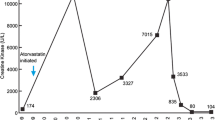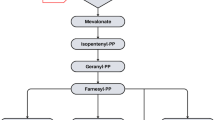Abstract
The spectrum of statin-induced myopathy includes myalgias and weakness, with or without CK elevation, and in its most severe form rhabdomyolysis with renal failure. Myalgias are not uncommon, occurring in about 10% of statin users, but myopathy with CK elevation is much rarer (~ 0.5%).
The risk for myopathy is substantially increased when concomitant medication is taken that interferes with the cytochrome P450 (CYP3A4) detoxification system. In those cases, pravastatin, fluvastatin or rosuvastatin, which undergo metabolism by a different route, should be chosen. Other risk factors are certain patient characteristics (age, systemic illness, underlying neuromuscular disorder, vitamin D-deficiency, genetic variants of hepatic drug transporters) or drug characteristics (type and dose of statin, co-medication).
Pathogenesis of statin myopathy is complex and involves the mevalonate metabolic pathway, direct effects on mitochondria and indirect pro-apoptotic effects, but also immune mechanisms (autoantibodies against HMG-CoA reductase, necrotizing myopathy).
The management of statin-induced myopathy is straightforward in many cases, simply discontinuing the responsible agent. Re-administration of the statin is possible in half the cases using a lower dose and/or a different statin with less intrinsic myotoxicity. Alternative diagnoses (other neuromuscular disorders or autoimmune necrotizing myopathy) have to be considered, if symptoms or CK elevations persist for more than six months after cessation of statin therapy. An algorithm for the management of these patients is presented.
Access this chapter
Tax calculation will be finalised at checkout
Purchases are for personal use only
Similar content being viewed by others
References
Heart Protection Study Collaborative Group (2002) MRC/BHF Heart Protection Study of cholesterol lowering with simvastatin in 20,536 high-risk individuals: a randomised placebo-controlled trial. Lancet (London England) 360:7–22
Reiner Z, Catapano AL, De Backer G et al (2011) ESC/EAS Guidelines for the management of dyslipidaemias: the Task Force for the management of dyslipidaemias of the European Society of Cardiology (ESC) and the European Atherosclerosis Society (EAS). Eur Heart J 32:1769–1818
Baigent C, Keech A, Kearney PM et al (2005) Efficacy and safety of cholesterol-lowering treatment: prospective meta-analysis of data from 90,056 participants in 14 randomised trials of statins. Lancet (London England) 366:1267–1278
Law MR, Wald NJ, Rudnicka AR (2003) Quantifying effect of statins on low density lipoprotein cholesterol, ischaemic heart disease, and stroke: systematic review and meta-analysis. BMJ 326:1423
Cohen JD, Brinton EA, Ito MK, Jacobson TA (2012) Understanding Statin Use in America and Gaps in Patient Education (USAGE): an internet-based survey of 10,138 current and former statin users. J Clin Lipidol 6:208–215
Willerson JT, Ridker PM (2004) Inflammation as a cardiovascular risk factor. Circulation 109:II2–II10
East C, Alivizatos PA, Grundy SM et al (1988) Rhabdomyolysis in patients receiving lovastatin after cardiac transplantation. N Engl J Med 318:47–48
Staffa JA, Chang J, Green L (2002) Cerivastatin and reports of fatal rhabdomyolysis. N Engl J Med 346:539–540
Rosenson RS, Baker SK, Jacobson TA et al (2014) An assessment by the statin muscle safety task force: 2014 update. J Clin Lipidol 8:S58–S71
Bruckert E, Hayem G, Dejager S et al (2005) Mild to moderate muscular symptoms with high-dosage statin therapy in hyperlipidemic patients–the PRIMO study. Cardiovasc Drugs Ther 19:403–414
Buettner C, Rippberger MJ, Smith JK et al (2012) Statin use and musculoskeletal pain among adults with and without arthritis. Am J Med 125:176–182
Zhang H, Plutzky J, Skentzos S et al (2013) Discontinuation of statins in routine care settings: a cohort study. Ann Intern Med 158:526–534
Ridker PM, Danielson E, Fonseca FAH et al (2008) Rosuvastatin to prevent vascular events in men and women with elevated C-reactive protein. N Engl J Med 359:2195–2207
Kashani A, Phillips CO, Foody JM et al (2006) Risks associated with statin therapy: a systematic overview of randomized clinical trials. Circulation 114:2788–2797
Ganga HV, Slim HB, Thompson PD (2014) A systematic review of statin-induced muscle problems in clinical trials. Am Heart J 168:6–15
Kjekshus J, Apetrei E, Barrios V et al (2007) Rosuvastatin in older patients with systolic heart failure. N Engl J Med 357:2248–2261
Parker BA, Capizzi JA, Grimaldi AS et al (2013) Effect of statins on skeletal muscle function. Circulation 127:96–103
Pedersen TR, Berg K, Cook TJ et al (1996) Safety and tolerability of cholesterol lowering with simvastatin during 5 years in the Scandinavian Simvastatin Survival Study. Arch Intern Med 156:2085–2092
Armitage J, Bowman L, Wallendszus K et al (2010) Intensive lowering of LDL cholesterol with 80 mg versus 20 mg simvastatin daily in 12,064 survivors of myocardial infarction: a double-blind randomised trial. Lancet (London England) 376:1658–1669
Newman C, Tsai J, Szarek M et al (2006) Comparative safety of atorvastatin 80 mg versus 10 mg derived from analysis of 49 completed trials in 14,236 patients. Am J Cardiol 97:61–67
Yamazaki T, Nohara R, Daida H et al (2013) Intensive lipid-lowering therapy for slowing progression as well as inducing regression of atherosclerosis in Japanese patients: subanalysis of the JART study. Int Heart J 54:33–39
Rundek T, Naini A, Sacco R et al (2004) Atorvastatin decreases the coenzyme Q10 level in the blood of patients at risk for cardiovascular disease and stroke. Arch Neurol 61:889–892
Paiva H, Thelen KM, Van Coster R et al (2005) High-dose statins and skeletal muscle metabolism in humans: a randomized, controlled trial. Clin Pharmacol Ther 78:60–68
Lamperti C, Naini AB, Lucchini V et al (2005) Muscle coenzyme Q10 level in statin-related myopathy. Arch Neurol 62:1709–1712
Phillips PS, Haas RH, Bannykh S et al (2002) Statin-associated myopathy with normal creatine kinase levels. Ann Intern Med 137:581–585
Stringer HAJ, Sohi GK, Maguire JA, Cote HCF (2013) Decreased skeletal muscle mitochondrial DNA in patients with statin-induced myopathy. J Neurol Sci 325:142–147
Nishimoto T, Tozawa R, Amano Y et al (2003) Comparing myotoxic effects of squalene synthase inhibitor, T-91485, and 3-hydroxy-3-methylglutaryl coenzyme A (HMG-CoA) reductase inhibitors in human myocytes. Biochem Pharmacol 66:2133–2139
Grable-Esposito P, Katzberg HD, Greenberg SA et al (2010) Immune-mediated necrotizing myopathy associated with statins. Muscle Nerve 41:185–190
Mammen AL, Chung T, Christopher-Stine L et al (2011) Autoantibodies against 3-hydroxy-3-methylglutaryl-coenzyme A reductase in patients with statin-associated autoimmune myopathy. Arthritis Rheum 63:713–721
Mohassel P, Mammen AL (2013) Statin-associated autoimmune myopathy and anti-HMGCR autoantibodies. Muscle Nerve 48:477–483
Vladutiu GD, Simmons Z, Isackson PJ et al (2006) Genetic risk factors associated with lipid-lowering drug-induced myopathies. Muscle Nerve 34:153–162
Link E, Parish S, Armitage J et al (2008) SLCO1B1 variants and statin-induced myopathy–a genome wide study. N Engl J Med 359:789–799
Needham M, Mastaglia FL (2014) Statin myotoxicity: a review of genetic susceptibility factors. Neuromuscul Disord 24:4–15
Oh J, Ban MR, Miskie BA et al (2007) Genetic determinants of statin intolerance. Lipids Health Dis 6:7
Hansen KE, Hildebrand JP, Ferguson EE, Stein JH (2005) Outcomes in 45 patients with statin-associated myopathy. Arch Intern Med 165:2671–2676
Draeger A, Monastyrskaya K, Mohaupt M et al (2006) Statin therapy induces ultrastructural damage in skeletal muscle in patients without myalgia. J Pathol 210:94–102
Meador BM, Huey KA (2010) Statin-associated myopathy and its exacerbation with exercise. Muscle Nerve 42:469–479
Dupuis L, Corcia P, Fergani A et al (2008) Dyslipidemia is a protective factor in amyotrophic lateral sclerosis. Neurology 70:1004–1009
Stroes ES, Thompson PD, Corsini A et al (2015) Statin-associated muscle symptoms: impact on statin therapy-European Atherosclerosis Society Consensus Panel Statement on Assessment, Aetiology and Management. Eur Heart J 36:1012–1022
Gupta A, Thompson PD (2011) The relationship of vitamin D deficiency to statin myopathy. Atherosclerosis 215:23–29
Banach M, Serban C, Sahebkar A et al (2015) Effects of coenzyme Q10 on statin-induced myopathy: a meta-analysis of randomized controlled trials. Mayo Clin Proc 90:24–34
Stein EA, Raal F (2014) Reduction of low-density lipoprotein cholesterol by monoclonal antibody inhibition of PCSK9. Annu Rev Med 65:417–431
Author information
Authors and Affiliations
Corresponding author
Editor information
Editors and Affiliations
Rights and permissions
Copyright information
© 2016 Springer International Publishing Switzerland
About this chapter
Cite this chapter
Schaefer, J., Jackson, S. (2016). Statin Myopathy. In: Angelini, C. (eds) Acquired Neuromuscular Disorders. Springer, Cham. https://doi.org/10.1007/978-3-319-29514-5_8
Download citation
DOI: https://doi.org/10.1007/978-3-319-29514-5_8
Published:
Publisher Name: Springer, Cham
Print ISBN: 978-3-319-29512-1
Online ISBN: 978-3-319-29514-5
eBook Packages: MedicineMedicine (R0)




